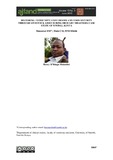Restoring community livelihoohods and food security through livestock asset during drought disasters: case study of Mwingi, Kenya

View/
Date
2015Author
Mutembei, HM
Mulei, CM
Mbithi, PMF.
Language
enMetadata
Show full item recordAbstract
Some of the world’s poor and most disaster-vulnerable communities are also those most reliant on livestock. Whenever disasters strike, in addition to the immediate devastation, food insecurity and loss of life, the loss of livestock can leave a secondary legacy of economic instability, debt and dependency. In 2011, a collaborative approach to mitigate both immediate and long-term effects of the devastating drought affecting Kenya’s livestock and people was conducted in Mwingi. In that year, East Africa had suffered the worst drought in 60 years following three years of poor or failed rains. More than 11 million people faced starvation in the region and in Kenya alone, 3.5 million people were affected by the crisis, which was declared a national disaster. For the people of Mwingi in Kenya, the keeping of livestock – including cattle, goats, sheep and camels – is the primary source of livelihoods and forms the basis of the regional economy. As the drought continued, daily life of Mwingi people became a struggle for survival for both people and their animals. Of their estimated animals thought to have been affected, in some areas, up to 45 per cent of the animal population died. A strategy to mitigate the effects of the drought was designed through participatory drought analysis and needs assessment. Subsequently, a drought response team was deployed in the region targeting to secure and restore valued asset of the people of Mwingi - the livestock. Management of livestock during that crisis helped to safeguard livelihoods and food security of the affected region. By the end of the disaster management there were perceived benefits in terms of improved body condition of the animals, avoided animal mortalities and indirect benefits derived from surviving livestock. With resumption of rains, farmers were able to continue depending upon their secured animals assets for livelihood. The cost-benefit analysis indicated the intervention generated $2.74 of benefits in the form of avoided losses for every $1 spent. If the time period was extended to 3 years, the benefit-cost ratio increases to $6.69 in benefits for every $1 spent. This case demonstrates that interventions on drought crisis focusing on actions aimed at animal welfare could help maintain and restore the livestock as a livelihoods asset of the regions’ farmers and help to enhance their food security.
Citation
Mutembei HM, Mulei CM, Mbithi PMF. "Restoring community Livelihoohods and Food Security through Livestock Asset during Drought Disasters: Case study of Mwingi, Kenya." Ajfand. 2015;15(3):10047-10059.Publisher
University of Nairobi
